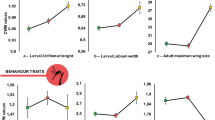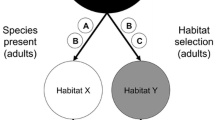Abstract
Contrasting life-history strategies of long versus short pre-reproductive phases are known in adult dragonflies (Odonata) of temperate regions. Because the long-phase species spend a longer time in terrestrial habitats such as grasslands or woodlands during their pre-reproductive phase, we hypothesized that long-phase species would be more sensitive to landscape structure than short-phase species. To test this hypothesis, we conducted periodic censuses of adult dragonflies at small man-made ponds. We compared the two above functional groups in terms of the degree to which species occurrence depended on landscape structure. The difference among the two groups was not significant, but occurrence of long-phase species tended to depend on landscape structure. Long-phase species responded to landscape structure at larger spatial scales and showed stronger spatial autocorrelation in their occurrence among sampling ponds than short-phase species.


Similar content being viewed by others
References
Andrén H, Delin A, Seiler A (1997) Population response to landscape changes depends on specialization to different landscape elements. Oikos 80:193–196
Bernath B, Szedenics G, Wildermuth H, Horvath G (2002) How can dragonflies discern bright and dark waters from a distance? The degree of polarisation of reflected light as a possible cue for dragonfly habitat selection. Freshw Biol 47:1707–1719
Borcard D, Legendre P, Drapeau P (1992) Partialling out the spatial component of ecological variation. Ecology 73:1045–1055
Burnham KP, Anderson DR (2002) Model selection and multimodel inference: a practical information-theoretic approach. Springer, New York
Conrad KF, Willson KH, Harvey IF, Thomas CJ, Sherratt TN (1999) Dispersal characteristics of seven odonate species in an agricultural landscape. Ecography 22:524–531
Corbet PS (1999) Dragonflies: behavior and ecology of Odonata. Cornell University Press, New York
Driscoll DA, Weir T (2005) Beetle responses to habitat fragmentation depend on ecological traits, habitat condition, and remnant size. Conserv Biol 19:182–194
Ewers RM, Didham RK (2006) Confounding factors in the detection of species responses to habitat fragmentation. Biol Rev 81:117–142
Fahrig L (2003) Effects of habitat fragmentation on biodiversity. Annu Rev Ecol Evol Systemat 34:487–515
Fielding AH, Bell JF (1997) A review of methods for the assessment of prediction errors in conservation presence/absence models. Environ Conserv 24:38–49
Fincke OM (1992) Interspecific competition for tree holes: consequences for mating systems and coexistence in Neotropical damselflies. Am Nat 139:80–101
Halpern BS, Gaines SD, Warner RR (2005) Habitat size, recruitment, and longevity as factors limiting population size in stage-structured species. Am Nat 165:82–94
Henle K, Davies KF, Kleyer M, Margules C, Settele J (2004) Predictors of species sensitivity to fragmentation. Biodiv Conserv 13:207–251
Johnson JB, Omland KS (2004) Model selection in ecology and evolution. Trends Ecol Evol 19:101–108
Kadoya T, Suda S, Washitani I (2004) Dragonfly species richness on man-made ponds: effects of pond size and pond age on newly established assemblages. Ecol Res 19:461–467
Knaus P, Wildermuth H (2002) Site attachment and displacement of adults in two alpine metapopulations of Somatochlora alpestris (Odonata:Corduliidae). Int J Odonatol 5:111–128
Knight TM, McCoy MW, Chase JM, McCoy KA, Holt RD (2005) Trophic cascades across ecosystems. Nature 437:880–883
Krawchuk MA, Taylor PD (2003) Changing importance of habitat structure across multiple spatial scales for three species of insects. Oikos 103:153–161
Legendre P (1993) Spatial autocorrelation: trouble or new paradigm. Ecology 74:1659–1673
Manel S, Williams HC, Ormerod SJ (2001) Evaluating presence-absence models in ecology: the need to account for prevalence. J Appl Ecol 38:921–931
Morton ES (1977) Ecology and behavior of some Panamanian Odonata. Proc Entomol Soc Wash 79:273–273
Pope SE, Fahrig L, Merriam NG (2000) Landscape complementation and metapopulation effects on leopard frog populations. Ecology 81:2498–2508
Purse BV, Hopkins GW, Day KJ, Thompson DJ (2003) Dispersal characteristics and management of a rare damselfly. J Appl Ecol 40:716–728
Purtauf T, Dauber J, Wolters V (2005) The response of carabids to landscape simplification differs between trophic groups. Oecologia 142:458–464
Rhodes JR, Wiegand T, McAlpine CA, Callaghan J, Lunney D, Bowen M, Possingham HP (2006) Modeling species’ distributions to improve conservation in semiurban landscapes: Koala case study. Conserv Biol 20:449–459
Steyler NS, Samways MJ (1995) Biotope selection by adult male dragonflies (Odonata) at an artificial lake created for insect conservation in South Africa. Biol Conserv 72:381–386
Sugimura M, Ishida S, Kojima K, Ishida K, Aoki H (1999) Dragonflies of the Japanese archipelago in color (in Japanese). Hokkaido University Press, Sapporo
Taguchi M (1987) Population ecology of Sympetrum spp. in paddy fields surrounded by hills (in Japanese). Insect Nat 22:7–12
Van Buskirk J (2005) Local and landscape influence on amphibian occurrence and abundance. Ecology 86:1936–1947
Washitani I (2003) Restoration of aquatic ecosystems. In: Takeuchi K, Brown RD, Washitani I, Tsunekawa A, Yokohari M (eds) Satoyama: the traditional rural landscape of Japan. Springer, Tokyo, pp 143–147
Watanabe M, Taguchi M (1988) Community structure of coexisting Sympetrum species in the central Japanese paddy fields in autumn (Anisoptera Libellulidae). Odonatologica 17:249–262
Watanabe M, Matsuoka H, Taguchi M (2004) Habitat selection and population parameters of Sympetrumin fuscatum (Selys) during sexually mature stages in a cool temperate zone of Japan (Anisoptera: Libellulidae). Odonatologica 33:169–179
Watanabe M, Matsuoka H, Susa K, Taguchi M (2005) Thoracic temperature in Sympetrum infuscatum (Selys) in relation to habitat and activity (Anisoptera: Libellulidae). Odonatologica 34:271–283
Wilbur HM (1980) Complex life cycles. Annu Rev Ecol Systemat 11:67–93
Yoshida M, Yagi T, Muraki A (1998) Dragonflies and Damselflies (Insecta:Odonata) of Shiga Prefecture, Honshu, Japan (in Japanese). Lake Biwa Museum, Kusatsu
Acknowledgments
We thank P.D. Taylor for critically reading the original manuscript and providing helpful comments and suggestions and Y. Yamaura for advice regarding statistics. We also thank G. Fujita, J. Nishihiro and three anonymous referees for helpful comments on earlier versions of the manuscript, A. Goto for assistance in the field and H. Iijima (NPO Asaza Fund) for encouragement during the course of this study. We especially thank the primary-school teachers and students in Ibaraki Prefecture for allowing us to study dragonflies in their ponds. This study was partly supported by a grant from the Japan Society for the Promotion of Science (JSPS 17-11543).
Author information
Authors and Affiliations
Corresponding author
Rights and permissions
About this article
Cite this article
Kadoya, T., Suda, Si., Tsubaki, Y. et al. The sensitivity of dragonflies to landscape structure differs between life-history groups. Landscape Ecol 23, 149–158 (2008). https://doi.org/10.1007/s10980-007-9151-1
Received:
Accepted:
Published:
Issue Date:
DOI: https://doi.org/10.1007/s10980-007-9151-1




